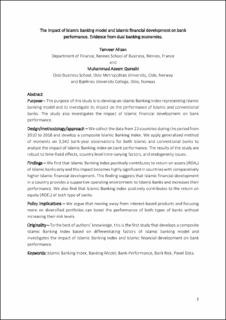| dc.contributor.author | Ahsan, Tanveer | |
| dc.contributor.author | Qureshi, Muhammad Azeem | |
| dc.date.accessioned | 2022-02-02T08:12:52Z | |
| dc.date.available | 2022-02-02T08:12:52Z | |
| dc.date.created | 2021-09-27T09:46:44Z | |
| dc.date.issued | 2021 | |
| dc.identifier.issn | 1753-8394 | |
| dc.identifier.uri | https://hdl.handle.net/11250/2976542 | |
| dc.description.abstract | Purpose
The purpose of this study is to develop an Islamic Banking Index representing the Islamic banking model and to investigate its impact on the performance of Islamic and conventional banks. This study also analyzes the impact of Islamic financial development on bank performance.
Design/methodology/approach
The authors collected the data from 23 countries for the period from 2010 to 2018 and developed a composite Islamic Banking Index. The authors applied the generalized method of moments on 3,542 bank-year observations for both Islamic and conventional banks to analyze the impact of the Islamic Banking Index on bank performance. The results of the study are robust to time-fixed effects, country-level time-varying factors and endogeneity issues.
Findings
The authors found that Islamic Banking Index positively contributes to the return on assets (ROAit) of Islamic banks only. This impact becomes highly significant in countries with comparatively higher Islamic financial development. This finding suggests that the Islamic financial development in a country provides a supportive operating environment to Islamic banks and increases their performance. The authors also found that Islamic Banking Index positively contributes to the return on equity (ROEit) of both types of banks.
Practical implications
The authors argue that moving away from interest-based products and focusing more on diversified portfolios can boost the performance of both types of banks without increasing their risk levels.
Originality/value
To the best of the authors’ knowledge, this is the first study that develops a composite Islamic Banking Index based on differentiating factors of the Islamic banking model and investigates the impact of Islamic Banking Index and Islamic financial development on bank performance. | en_US |
| dc.language.iso | eng | en_US |
| dc.publisher | Emerald | en_US |
| dc.subject | Islamic banking index | en_US |
| dc.subject | Bank risk | en_US |
| dc.subject | Panel data | en_US |
| dc.title | The impact of Islamic banking model and Islamic financial development on bank performance: Evidence from dual banking economies | en_US |
| dc.type | Peer reviewed | en_US |
| dc.type | Journal article | en_US |
| dc.description.version | acceptedVersion | en_US |
| cristin.ispublished | true | |
| cristin.fulltext | original | |
| cristin.qualitycode | 1 | |
| dc.identifier.doi | 10.1108/IMEFM-05-2020-0248 | |
| dc.identifier.cristin | 1938767 | |
| dc.source.journal | International Journal of Islamic and Middle Eastern Finance and Management | en_US |
| dc.subject.nsi | VDP::Samfunnsvitenskap: 200::Økonomi: 210 | en_US |
